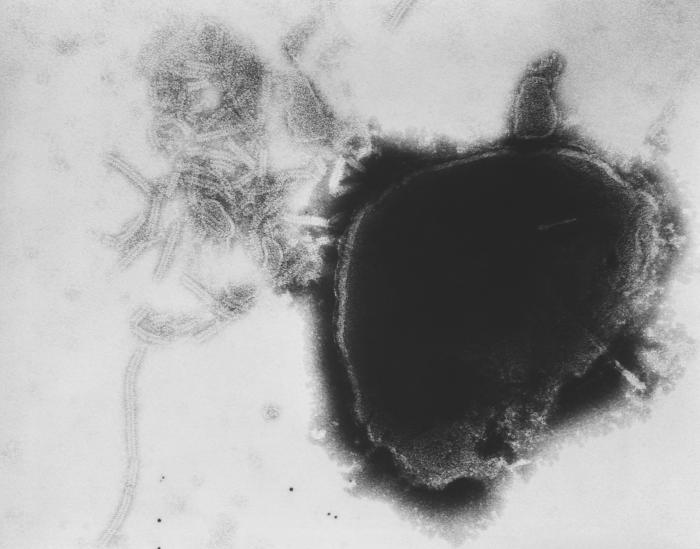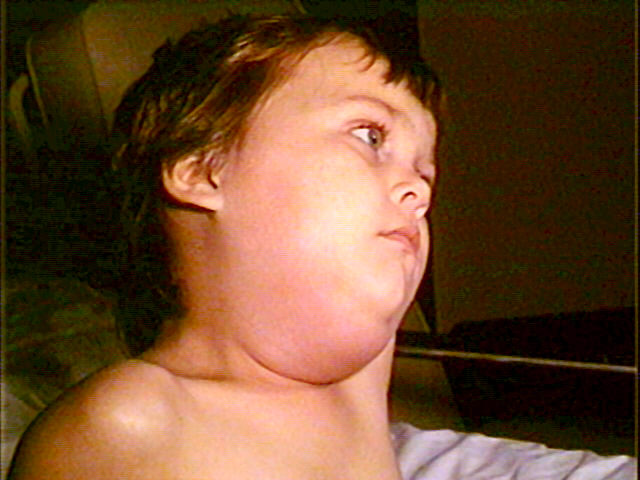[1]
Lam E, Rosen JB, Zucker JR. Mumps: an Update on Outbreaks, Vaccine Efficacy, and Genomic Diversity. Clinical microbiology reviews. 2020 Mar 18:33(2):. doi: 10.1128/CMR.00151-19. Epub 2020 Feb 26
[PubMed PMID: 32102901]
[2]
Almansour I. Mumps Vaccines: Current Challenges and Future Prospects. Frontiers in microbiology. 2020:11():1999. doi: 10.3389/fmicb.2020.01999. Epub 2020 Aug 20
[PubMed PMID: 32973721]
[3]
Su SB, Chang HL, Chen AK. Current Status of Mumps Virus Infection: Epidemiology, Pathogenesis, and Vaccine. International journal of environmental research and public health. 2020 Mar 5:17(5):. doi: 10.3390/ijerph17051686. Epub 2020 Mar 5
[PubMed PMID: 32150969]
[4]
Wu H, Wang F, Tang D, Han D. Mumps Orchitis: Clinical Aspects and Mechanisms. Frontiers in immunology. 2021:12():582946. doi: 10.3389/fimmu.2021.582946. Epub 2021 Mar 18
[PubMed PMID: 33815357]
[5]
Marin M, Marlow M, Moore KL, Patel M. Recommendation of the Advisory Committee on Immunization Practices for Use of a Third Dose of Mumps Virus-Containing Vaccine in Persons at Increased Risk for Mumps During an Outbreak. MMWR. Morbidity and mortality weekly report. 2018 Jan 12:67(1):33-38. doi: 10.15585/mmwr.mm6701a7. Epub 2018 Jan 12
[PubMed PMID: 29324728]
[6]
Hviid A, Rubin S, Mühlemann K. Mumps. Lancet (London, England). 2008 Mar 15:371(9616):932-44. doi: 10.1016/S0140-6736(08)60419-5. Epub
[PubMed PMID: 18342688]
[7]
Shepersky L, Marin M, Zhang J, Pham H, Marlow MA. Mumps in Vaccinated Children and Adolescents: 2007-2019. Pediatrics. 2021 Dec 1:148(6):. pii: e2021051873. doi: 10.1542/peds.2021-051873. Epub
[PubMed PMID: 34814181]
[8]
Shah M, Quinlisk P, Weigel A, Riley J, James L, Patterson J, Hickman C, Rota PA, Stewart R, Clemmons N, Kalas N, Cardemil C, Iowa Mumps Outbreak Response Team. Mumps Outbreak in a Highly Vaccinated University-Affiliated Setting Before and After a Measles-Mumps-Rubella Vaccination Campaign-Iowa, July 2015-May 2016. Clinical infectious diseases : an official publication of the Infectious Diseases Society of America. 2018 Jan 6:66(1):81-88. doi: 10.1093/cid/cix718. Epub
[PubMed PMID: 29020324]
[9]
RUSSELL RR, DONALD JC. The neurological complications of mumps. British medical journal. 1958 Jul 5:2(5087):27-30
[PubMed PMID: 13546635]
[10]
Dayan GH, Quinlisk MP, Parker AA, Barskey AE, Harris ML, Schwartz JM, Hunt K, Finley CG, Leschinsky DP, O'Keefe AL, Clayton J, Kightlinger LK, Dietle EG, Berg J, Kenyon CL, Goldstein ST, Stokley SK, Redd SB, Rota PA, Rota J, Bi D, Roush SW, Bridges CB, Santibanez TA, Parashar U, Bellini WJ, Seward JF. Recent resurgence of mumps in the United States. The New England journal of medicine. 2008 Apr 10:358(15):1580-9. doi: 10.1056/NEJMoa0706589. Epub
[PubMed PMID: 18403766]
[11]
Siegel M, Fuerst HT, Peress NS. Comparative fetal mortality in maternal virus diseases. A prospective study on rubella, measles, mumps, chicken pox and hepatitis. The New England journal of medicine. 1966 Apr 7:274(14):768-71
[PubMed PMID: 17926883]
Level 2 (mid-level) evidence
[12]
Enders M, Rist B, Enders G. [Frequency of spontaneous abortion and premature birth after acute mumps infection in pregnancy]. Gynakologisch-geburtshilfliche Rundschau. 2005 Jan:45(1):39-43
[PubMed PMID: 15644639]
[13]
McNabb SJ, Jajosky RA, Hall-Baker PA, Adams DA, Sharp P, Anderson WJ, Javier AJ, Jones GJ, Nitschke DA, Worshams CA, Richard RA Jr, Centers for Disease Control and Prevention (CDC). Summary of notifiable diseases --- United States, 2005. MMWR. Morbidity and mortality weekly report. 2007 Mar 30:54(53):1-92
[PubMed PMID: 17392681]
[14]
Centers for Disease Control and Prevention (CDC). Updated recommendations for isolation of persons with mumps. MMWR. Morbidity and mortality weekly report. 2008 Oct 10:57(40):1103-5
[PubMed PMID: 18846033]
[15]
Brook I. Diagnosis and management of parotitis. Archives of otolaryngology--head & neck surgery. 1992 May:118(5):469-71
[PubMed PMID: 1571113]
[16]
Wright WF, Pinto CN, Palisoc K, Baghli S. Viral (aseptic) meningitis: A review. Journal of the neurological sciences. 2019 Mar 15:398():176-183. doi: 10.1016/j.jns.2019.01.050. Epub 2019 Jan 31
[PubMed PMID: 30731305]
[17]
Trojian TH, Lishnak TS, Heiman D. Epididymitis and orchitis: an overview. American family physician. 2009 Apr 1:79(7):583-7
[PubMed PMID: 19378875]
Level 3 (low-level) evidence
[18]
the Association for the Study of Infectious Disease. A retrospective survey of the complications of mumps. The Journal of the Royal College of General Practitioners. 1974 Aug:24(145):552-6
[PubMed PMID: 4465449]
Level 2 (mid-level) evidence
[20]
Barskey AE, Schulte C, Rosen JB, Handschur EF, Rausch-Phung E, Doll MK, Cummings KP, Alleyne EO, High P, Lawler J, Apostolou A, Blog D, Zimmerman CM, Montana B, Harpaz R, Hickman CJ, Rota PA, Rota JS, Bellini WJ, Gallagher KM. Mumps outbreak in Orthodox Jewish communities in the United States. The New England journal of medicine. 2012 Nov 1:367(18):1704-13. doi: 10.1056/NEJMoa1202865. Epub
[PubMed PMID: 23113481]
[21]
Zamir CS, Schroeder H, Shoob H, Abramson N, Zentner G. Characteristics of a large mumps outbreak: Clinical severity, complications and association with vaccination status of mumps outbreak cases. Human vaccines & immunotherapeutics. 2015:11(6):1413-7. doi: 10.1080/21645515.2015.1021522. Epub
[PubMed PMID: 25874726]
Level 3 (low-level) evidence
[22]
Di Pietrantonj C, Rivetti A, Marchione P, Debalini MG, Demicheli V. Vaccines for measles, mumps, rubella, and varicella in children. The Cochrane database of systematic reviews. 2021 Nov 22:11(11):CD004407. doi: 10.1002/14651858.CD004407.pub5. Epub 2021 Nov 22
[PubMed PMID: 34806766]
Level 1 (high-level) evidence
[23]
McLean HQ, Fiebelkorn AP, Temte JL, Wallace GS, Centers for Disease Control and Prevention. Prevention of measles, rubella, congenital rubella syndrome, and mumps, 2013: summary recommendations of the Advisory Committee on Immunization Practices (ACIP). MMWR. Recommendations and reports : Morbidity and mortality weekly report. Recommendations and reports. 2013 Jun 14:62(RR-04):1-34
[PubMed PMID: 23760231]
[24]
Ogbuanu IU, Kutty PK, Hudson JM, Blog D, Abedi GR, Goodell S, Lawler J, McLean HQ, Pollock L, Rausch-Phung E, Schulte C, Valure B, Armstrong GL, Gallagher K. Impact of a third dose of measles-mumps-rubella vaccine on a mumps outbreak. Pediatrics. 2012 Dec:130(6):e1567-74. doi: 10.1542/peds.2012-0177. Epub 2012 Nov 5
[PubMed PMID: 23129075]
[25]
Nelson GE, Aguon A, Valencia E, Oliva R, Guerrero ML, Reyes R, Lizama A, Diras D, Mathew A, Camacho EJ, Monforte MN, Chen TH, Mahamud A, Kutty PK, Hickman C, Bellini WJ, Seward JF, Gallagher K, Fiebelkorn AP. Epidemiology of a mumps outbreak in a highly vaccinated island population and use of a third dose of measles-mumps-rubella vaccine for outbreak control--Guam 2009 to 2010. The Pediatric infectious disease journal. 2013 Apr:32(4):374-80. doi: 10.1097/INF.0b013e318279f593. Epub
[PubMed PMID: 23099425]
[26]
Cardemil CV, Dahl RM, James L, Wannemuehler K, Gary HE, Shah M, Marin M, Riley J, Feikin DR, Patel M, Quinlisk P. Effectiveness of a Third Dose of MMR Vaccine for Mumps Outbreak Control. The New England journal of medicine. 2017 Sep 7:377(10):947-956. doi: 10.1056/NEJMoa1703309. Epub
[PubMed PMID: 28877026]
[27]
Abedi GR, Mutuc JD, Lawler J, Leroy ZC, Hudson JM, Blog DS, Schulte CR, Rausch-Phung E, Ogbuanu IU, Gallagher K, Kutty PK. Adverse events following a third dose of measles, mumps, and rubella vaccine in a mumps outbreak. Vaccine. 2012 Nov 19:30(49):7052-8. doi: 10.1016/j.vaccine.2012.09.053. Epub 2012 Oct 3
[PubMed PMID: 23041123]
[28]
Seither R, Yusuf OB, Dramann D, Calhoun K, Mugerwa-Kasujja A, Knighton CL. Coverage with Selected Vaccines and Exemption from School Vaccine Requirements Among Children in Kindergarten - United States, 2022-23 School Year. MMWR. Morbidity and mortality weekly report. 2023 Nov 10:72(45):1217-1224. doi: 10.15585/mmwr.mm7245a2. Epub 2023 Nov 10
[PubMed PMID: 37943705]
[29]
Barbel P, Peterson K, Heavey E. Mumps makes a comeback: What nurses need to know. Nursing. 2017 Jan:47(1):15-17. doi: 10.1097/01.NURSE.0000510761.53098.22. Epub
[PubMed PMID: 28027128]


